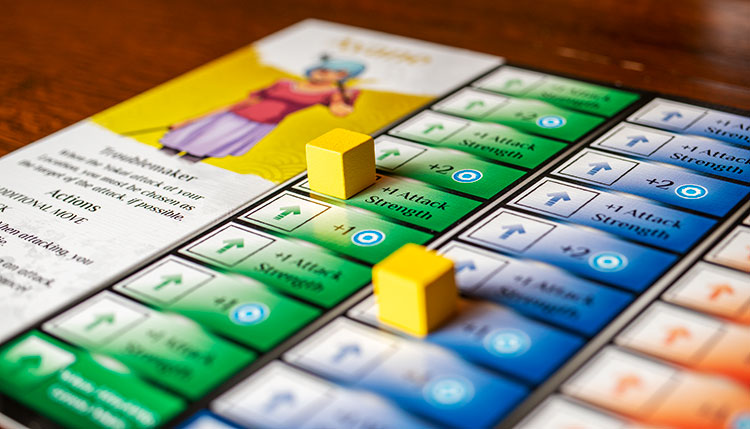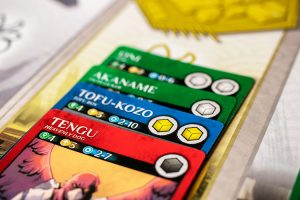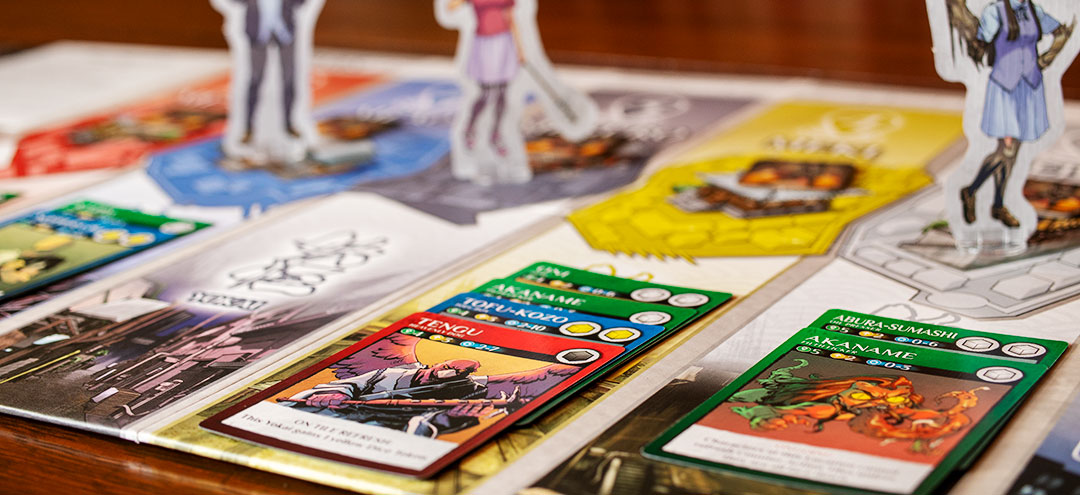 If you aren’t familiar with it, Wayward is a comic book series published by IDW. The comic centers around teenagers imbued with supernatural power who defend the world from Yokai, Japanese mythological creatures and spirits. When IDW first sent over a review copy of the Wayward board game, I knew nothing of the comic book. But the art intrigued me, so I fired up my copy of Hoopla and checked out the first few issues. I must say, it’s a really good book.
If you aren’t familiar with it, Wayward is a comic book series published by IDW. The comic centers around teenagers imbued with supernatural power who defend the world from Yokai, Japanese mythological creatures and spirits. When IDW first sent over a review copy of the Wayward board game, I knew nothing of the comic book. But the art intrigued me, so I fired up my copy of Hoopla and checked out the first few issues. I must say, it’s a really good book.
Over on your gaming table, the Wayward board game drops players into the shoes of the five main characters from the comic book. Players are tasked with taking down a unique bad guy and stomping some evil Yokai in the process. Did Wayward do a good job of bringing the comic series to our tabletops? Let’s find out.
Gameplay Overview:
Wayward comes with five unique adversaries (scenarios), each of which has its own requirements to win. The best one to start with is Tsuchigumo, a creepy spider monster. For this scenario, players must defeat all five of his proxy tokens before the Weave (a source of mystical energy) completely unravels.

To start, each player chooses one of five unique heroes to control. Each hero is good in a specific area: for example, Ayane is a combat bruiser that is great at smashing Yokai, while Emi’s steel skin can absorb a lot of damage for the team.
Beginning with the first player, each player takes a turn with the following three phases:
1. Refresh Counter Action Tiles (optional): This is the only way to flip the Counter Action tiles back faceup. When this happens, the strongest Yokai will attack the Weave and a new enemy event card is drawn.
2. Choose a Counter Action tile: There are 6 tiles provided by the scenario. Whichever tile you choose will give you energy to use, but also help the bad guy in some way (spawning Yokai, activating Yokai, etc…)
3. Character Actions: Energy can be spent to take actions (moving, attacking, using abilities, shopping). Attacks are handled via a unique betting system. A player decides how much energy they want to spend, then they roll the dice listed on the Yokia’s Card. If the results are equal or less than the energy spent, the Yokai is killed and upgrade points are awarded. If not, then the action fails and the character potentially takes some damage.
Upgrade points can be spent to advance one of your character’s three tracks. These will usually grant either a one time gift of energy or it will make your character’s abilities stronger (bonuses to attacks, discount on powers, re-rolls, etc…).
Players take turns in this manner until either the loss condition is reached (usually the Weave is unrivaled) or the scenario goals are achieved.

Game Experience:
After reading through the first series of Wayward, I have to hand it to designer Jonathan Gilmour. He not only did a good job of capturing the spirit of the comic books, but he did it using a lot of new and innovative mechanics.
The strongest thing Wayward has going for it (other than the theme if you are a fan) is how fresh the gameplay feels. This isn’t just another cooperative game rehashing the same ideas with a new skin.

The combat system is great for those who love to press their luck. There is definitely a risk vs reward feel to it. You decide how much energy you want to spend and then roll the dice. Roll low, and you’ll defeat the Yokai, but feel like you wasted too much energy. Roll too high and you’ll be wishing you spent more! For those who love to gamble, you can have a lot of fun here. For those who don’t, the cards always give you the range of the possible dice rolls, so you can at least hedge your bets.
I also thought that the Counter Action tile system was great. Instead of being a slave to a card draw, players have a lot of agency as to when the bad things happen. Don’t want the red Yokai to attack yet? Then pick a different tile. Yet the energy gain is tied to the tiles, so those really terrible tiles are going to have the highest energy output. It was a nice balancing act.

I was also a fan of the upgrade system. Not only do players get three upgrade tracks that they can advance in any order, but the upgrade points are distributed evenly among players. So if a monster awards 3 upgrade points, the first point will go to the person who last didn’t get one, followed by the rest being distributed in a clockwise manner. This means that even though Ayane may be doing most of the killing, the support role characters can still get their due. It’s a good system that encourages players to play to their character’s strengths.
For all the clever ideas, there were a couple of things that didn’t go as smoothly for us. First, The Yokai cards can get a bit fiddly. There can be many different Yokai out on the board at any given time. Some have ongoing effects, some take place during counter tile resets, and still, others happen when they are revealed. I felt like I spent an inordinate amount of time trying to make sure I was taking all the card effects into account. Some streamlining here would have been welcome.

I also thought that the monster event cards felt a bit swingy. While some benefited the players, many didn’t. All in all though, they felt a little random and I question whether they were wholly necessary. That being said, I do appreciate how differently the various adversaries felt. Some will have you trying to close off locations, others will have you facing different events, and still, others are straight-up brawls. This helps to give Wayward a solid amount of replay value.
Final Thoughts:
I’m always a bit wary about games based on existing IPs, but IDW Games made a solid offering for Wayward fans with this one. Players get to control their favorite characters from the series and each has plenty of opportunities to shine. And with the ability to not only upgrade your character through combat, but buy items, there are a lot of ways to improve your character’s strengths during the game.
Whether or not you are a fan of the comic book series, you can have a lot of fun with this under the radar title. Jonathan Gilmour cooked up a lot of clever mechanics for the game that I’d be happy to see used more in the future.
Final Score: 4 Stars – Unique mechanics and a fun theme make this a fun game for fans of the comic series.
 Hits:
Hits:
• Fresh new game mechanics
• Characters and scenarios feel unique
• Combat system is great for push your luck fans
Misses:
• Yokai abilities can get a bit fiddly
• Event cards felt swingy






















